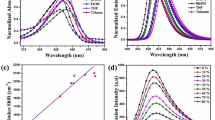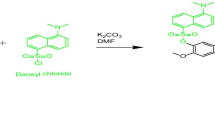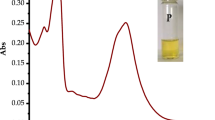Abstract
A new cationic indolium based styryl dye (Ci) as a fluorescent probe was synthesized and its anions selectivity/sensitivity properties/molecular interactions with protease enzymes (pepsin/trypsin) and ctDNA has been studied by spectroscopic and computational methods. The fluorescence measurements at different temperatures indicated that quenching mechanism of enzymes by Ci was static. ΔH and ΔS data pointed out electrostatic/hydrophobic interactions with pepsin, and also hydrogen bonds/van der Waals forces with trypsin of Ci. According to Förster’s non-radiative energy transfer, binding distances (r) were calculated as 3.53/3.27 nm for pepsin/trypsin. It was also investigated that groove binding is effective in interaction with ctDNA. The results were supported with molecular docking analyzes which have same tendency. Ci has been demonstrated hypsochromic effect with a decrease in polarity of solvents and it showed highly selective colorimetric and fluorometric sensing behavior for cyanide in organic solvent and in aqueous solution. 1H NMR titration was performed to examine the interaction mechanism between Ci and cyanide. The LOD values of cyanide ion were reported as 4.87 × 10–9 M and 9.70 × 10–7 M in DMSO and DMSO/H2O binary mixture, respectively. In addition, sensitivity of Ci as a chemosensor to cyanide was investigated in bitter almond samples.

















Similar content being viewed by others
References
Li Y, Wei F, Lu Y, He S, Zhao L, Zeng X (2013) Novel mercury sensor based on water soluble styrylindolium dye. Dyes Pigm 96:424–429. https://doi.org/10.1016/j.dyepig.2012.09.010
Gu J, Rao U, Fabio A, Monte L, Kramer T, von Haußen RH, Hölzer J, Goetschy-Meyer V, Mall G, Hilger I, Czech C, Schmidt B (2012) 2-Styrylindolium based fluorescent probes visualize neurofibrillary tangles in Alzheimer’s disease. Bioorg Med Chem Lett 22:7667–7671. https://doi.org/10.1016/j.bmcl.2012.09.109
Metsov S, Simov D, Stoyanov S, Nikolov P (1990) Photophysical characteristics of some 2-styrylindolium dyes. Dyes Pigm 13:11–19. https://doi.org/10.1016/0143-7208(90)80009-E
Promchat A, Rashatasakhon P, Sukwattanasinitt M (2017) A novel indolium salt as a highly sensitive and selective fluorescent sensor for cyanide detection in water. J Hazard Mater 329:255–261. https://doi.org/10.1016/j.jhazmat.2017.01.024
Wang S, Feia X, Guoa J, Yanga Q, Lia Y, Song Y (2016) A novel reaction-based colorimetric and ratiometric fluorescent sensor for cyanide anion with a large emission shift and high selectivity. Talanta 148:229–236. https://doi.org/10.1016/j.talanta.2015.10.058
Shiraishi Y, Itoh M, Hirai T (2011) Colorimetric response of spiropyran derivative for anions in aqueous or organic media. Tetrahedron 67:891–897. https://doi.org/10.1016/j.tet.2010.12.021
Perry A, Miles D (2016) An off-the-shelf sensor for colourimetric detection of sulfide. Tetrahedron Lett 57:5788–5793. https://doi.org/10.1016/j.tetlet.2016.11.040
Liu J, Sun YQ, Huo Y, Zhang H, Wang L, Zhang P, Song D, Shi Y, Guo W (2014) Simultaneous fluorescence sensing of Cys and GSH from different emission channels. J Am Chem Soc 136:574–577. https://doi.org/10.1021/ja409578w
Wu WL, Ma HL, Huang MF, Miao JY, Zhao BX (2017) Mitochondria-targeted ratiometric fluorescent probe based on FRET for bisulfite. Sens Actuators B 241:239–244. https://doi.org/10.1016/j.snb.2016.10.028
Yu Q, Zhang KY, Liang H, Zhao Q, Yang T, Liu S, Zhang C, Shi Z, Xu W, Huang W (2015) Dual-emissive nanohybrid for ratiometric luminescence and lifetime imaging of intracellular hydrogen sulfide. ACS Appl Mater Interfaces 7:5462–5470. https://doi.org/10.1021/am5091534
Gupta SP, Gupta SD (2020) Cancer-leading proteases structures, functions, and inhibition. Chapter 1, Elsevier: India
Pinto MR, Schanze KS (2004) Amplified fluorescence sensing of protease activity with conjugated polyelectrolytes. Proc Natl Acad Sci 101:7505–7510. https://doi.org/10.1073/pnas.0402280101
Li X, Ni T (2016) Binding of glutathione and melatonin to pepsin occurs via different binding mechanisms. Eur Biophys J 45:165–174. https://doi.org/10.1007/s00249-015-1085-y
Song W, Yu Z, Hu X, Liu R (2015) Dissection of the binding of hydrogen peroxide to trypsin using spectroscopic methods and molecular modeling. Spectrochim Acta Part A 137:286–293. https://doi.org/10.1016/j.saa.2014.08.037
Botti V, Cesaretti A, Ban Z, Crnolatac I, Consiglio G, Elisei F, Piantanida I (2019) Fine structural tuning of styryl-based dyes for f luorescence and CD-based sensing of various ds-DNA/RNA sequences. Org Biomol Chem 17:8243–8258. https://doi.org/10.1039/c9ob01186b
Barman S, Das J, Biswas S, Maiti TK, Singh NP (2017) A spiropyran-coumarin platform: An environment sensitive photoresponsive drug delivery system for efficient cancer therapy. J Mater Chem B 5:3940–3944. https://doi.org/10.1039/c7tb00379j
Lakowicz JR (2006) Principles of Fluorescence Spectroscopy. Plenum, New York
Becke AD (1993) Density-functional thermochemistry. III. The role of exact exchange. J Chem Phys 98:5648–5651. https://doi.org/10.1063/1.464913
Lee C, Yang W, Parr RG (1988) Development of the Colle-Salvetti correlation-energy formula into a functional of the electron density. Phys Rev B 37:785–789. https://doi.org/10.1103/PhysRevB.37.785
Miehlich B, Savin A, Stoll H, Preuss H (1989) Results obtained with the correlation energy density functionals of becke and Lee, Yang and Parr. Chem Phys Lett 157:200–206. https://doi.org/10.1016/0009-2614(89)87234-3
Frisch MJ et al (2009) Gaussian 09, Revision A.02. Gaussian, Inc., Wallingford, CT
Cossi M, Barone V (2001) Time-dependent density functional theory for molecules in liquid solutions. J Chem Phys 115:4708–4717. https://doi.org/10.1063/1.1394921
Bauernschmitt R, Ahlrichs R (1996) Treatment of electronic excitations within the adiabatic approximation of time dependent density functional theory. Chem Phys Lett 256:454–464. https://doi.org/10.1016/0009-2614(96)00440-X
Rose Y, Duarte JM, Lowe R et al (2021) RCSB protein data bank: architectural advances towards integrated searching and efficient access to macromolecular structure data from the PDB archive. J Mol Biol 433:166704. https://doi.org/10.1016/j.jmb.2020.11.003
Accelrys Software Inc (2013) Discovery Studio Modeling Environment, Release 3.5. Accelrys Software Inc, San Diego
Morris GM, Huey R, Lindstrom W, Sanner MF, Belew RK, Goodsell DS, Olson AJ (2009) AutoDock4 and AutoDockTools4: Automated docking with selective receptor flexibility. J Comput Chem 30:2785–2791. https://doi.org/10.1002/jcc.21256
Nural Y, Karasu E, Keleş E et al (2022) Synthesis of novel acylthioureas bearing naphthoquinone moiety as dual sensor for high-performance naked-eye colorimetric and fluorescence detection of CN− and F− ions and its application in water and food samples. Dyes Pigm 198:110006. https://doi.org/10.1016/j.dyepig.2021.110006
Park JH, Manivannan R, Jayasudha P, Son YA (2020) Spontaneous optical response towards cyanide ion in water by a reactive binding site probe. Spectrochim Acta Part A 233:118–190. https://doi.org/10.1016/j.saa.2020.118190
Sante OMDI (2004) World Health Organization, WWprogramme, WHO Staff, Zdrowia SO, WHO, Guidelines for drinking-water quality, Vol 1
Lakowicz JR, Weber G (1973) Quenching of fluorescence by oxygen. A probe for structural fluctuations in macromolecules. Biochemistry 12:4161–4170. https://doi.org/10.1021/bi00745a020
Mohseni-Shahri FS, Moeinpour F, Nosrati M (2018) Spectroscopy and molecular dynamics simulation study on the interaction of sunset yellow food additive with pepsin. Int J Biol Macromol 115:273–280. https://doi.org/10.1016/j.ijbiomac.2018.04.080
Bi S, Song D, Tian Y, Zhou X, Liu Z, Zhang H (2005) Molecular spectroscopic study on the interaction of tetracyclines with serum albumins. Spectrochim Acta Part A 61:629–636. https://doi.org/10.1016/j.saa.2004.05.028
Li X, Geng M (2016) Probing the binding of procyanidin B3 to trypsin and pepsin: A multi-technique approach. Int J Biol Macromol 85:168–178. https://doi.org/10.1016/j.ijbiomac.2015.12.075
Ross PD, Subramanian S (1981) Thermodynamics of protein association reactions: Forces contributing to stability. Biochemistry 20:3096–3102. https://doi.org/10.1021/bi00514a017
Zeng HJ, Yang D, Hua GZ, Yang R, Qu LB (2016) Studies on the binding of pepsin with three pyrethroid insecticides by multi-spectroscopic approaches and molecular docking. J Mol Recognit 29:476–484. https://doi.org/10.1002/jmr.2547
Förster T (1948) Intermolecular energy migration and fluorescence. Ann Physics 2:55–75
Lian S, Wang G, Zhou L, Yanga D (2013) Fluorescence spectroscopic analysis on interaction of fleroxacin with pepsin. Luminescence 28:967–972. https://doi.org/10.1002/bio.2469
Zhang HM, Zhou QH, Wang YQ (2010) Studies on the interactions of 2, 4-dinitrophenol and 2, 4-dichlorphenol with trypsin. J Fluoresc 20:507–516. https://doi.org/10.1007/s10895-009-0574-8
Moradi S, Ahmadi P, Karami C, Farhadian N, Balaei F, Ansari M, Shahlaei M (2021) Evaluation of the effects of isoniazid and rifampin on the structure and activity of pepsin enzyme by multi spectroscopy and molecular modeling methods. Spectrochim Acta Part A 253:119523. https://doi.org/10.1016/j.saa.2021.119523
Zhu S, Bai X, Zhu J, Li W, Wang B (2021) Multi-spectral techniques and molecular docking to investigation of the interaction between ferulic acid and pepsin. Spectrochim Acta Part A 251:119442. https://doi.org/10.1016/j.saa.2021.119442
Matei I, Hillebrand M (2010) Interaction of kaempferol with human serum albumin: A fluorescence and circular dichroism study. J Pharm Biomed Anal 51:768–773. https://doi.org/10.1016/j.jpba.2009.09.037
Li X, Ni T (2016) Probing the binding mechanisms of α-tocopherol to trypsin and pepsin using isothermal titration calorimetry, spectroscopic, and molecular modeling methods. J Biol Phys 42:415–434. https://doi.org/10.1007/s10867-016-9415-6
Siddigui MF, Khan MS, Husain FM, Bano B (2019) Deciphering the binding of carbendazim (fungicide) with human serum albumin: A multispectroscopic and molecular modelling studies. J Biomol Struct Dyn 37:2230–2241. https://doi.org/10.1080/07391102.2018.1481768
Wang Q, Zhang SR, Ji X (2014) Investigation of interaction of antibacterial drug sulfamethoxazole with human serum albumin by molecular modeling and multi-spectroscopic method. Spectrochim Acta Part A 124:84–90. https://doi.org/10.1016/j.saa.2013.12.100
Li X, Li P (2016) Study on the interaction of β-carotene and astaxanthin with trypsin and pepsin by spectroscopic techniques. Luminescence 31:782–792. https://doi.org/10.1002/bio.3024
Shahabadi N, Falsafi M, Maghsudi M (2017) DNA-binding study of anticancer drug cytarabine by spectroscopic and molecular docking techniques. Nucleosides, Nucleotides Nucleic Acids 36:49–65. https://doi.org/10.1080/15257770.2016.1218021
Soudani S, Kaabi K, Jelsch C, Mi JX, Lefebvre F, Nasr CB (2021) Synthesis, X-ray characterisation, hirshfeld surface and theoretical studies of a novel Cd(II) coordination compound bearing 2,3- pyridinedicarboxylic acid. Res Square. https://doi.org/10.21203/rs.3.rs-475047/v1
Mary YS, Varghese HT, Panicker CY, Girisha M, Sagar BK, Yathirajan HS, Al-Saadi AA, Alsenoy CV (2015) Vibrational spectra, HOMO, LUMO, NBO, MEP analysis and molecular docking study of 2,2-diphenyl-4-(piperidin-1-yl)butanamide. Spectrochim Acta Part A 150:543–556. https://doi.org/10.1016/j.saa.2015.05.090
Acknowledgements
The numerical calculations reported were partially performed at TUBITAK ULAKBIM, High Performance and Grid Computing Center (TRUBA resources).
Funding
This study was partially supported by Hacettepe University Scientific Research Fund (Project number: FBA2017-12854).
Author information
Authors and Affiliations
Contributions
Bensu Doyuran: Investigation, Writing-original draft. Elmas Gökoğlu: Data curation, Review & Editing. Ayman Zouitini: Synthesis, Investigation, Characterization. Ergin Keleş: Synthesis, Investigation, Characterization. Tugba Taskin-Tok: The theoretical calculations. Nurgül Seferoğlu: The theoretical calculations. Zeynel Seferoğlu: Data curation, Writing-original draft.
Corresponding author
Ethics declarations
Competing Interests
The authors declare no competing interests.
Ethics Approval
Not applicable.
Consent to Participate
Not applicable.
Consent for Publication
Not applicable.
Conflicts of Interest
The authors declare that they have no competing interests.
Additional information
Publisher's Note
Springer Nature remains neutral with regard to jurisdictional claims in published maps and institutional affiliations.
Supplementary Information
Below is the link to the electronic supplementary material.
Rights and permissions
Springer Nature or its licensor holds exclusive rights to this article under a publishing agreement with the author(s) or other rightsholder(s); author self-archiving of the accepted manuscript version of this article is solely governed by the terms of such publishing agreement and applicable law.
About this article
Cite this article
Doyuran, B., Gökoğlu, E., Zouitini, A. et al. A Novel Fluorescent Probe for the Detection of Cyanide Ions in Solutions and Studies on Its Biophysical Interactions with ctDNA and Proteases. J Fluoresc 32, 2173–2188 (2022). https://doi.org/10.1007/s10895-022-03014-0
Received:
Accepted:
Published:
Issue Date:
DOI: https://doi.org/10.1007/s10895-022-03014-0




